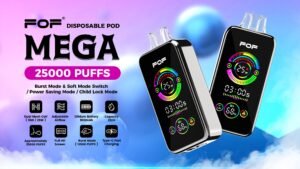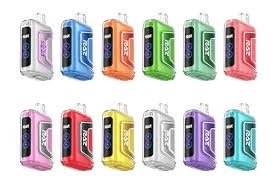Feeling overwhelmed by the alphabet soup of vape juice ingredients? You're not alone. Many vapers use e-liquids daily without understanding what VG, PG, and PEG actually are or how they affect their vaping experience.
VG (vegetable glycerin), PG (propylene glycol), and PEG (polyethylene glycol) are the main carrier bases in e-juice. VG is thicker, producing dense clouds with mild throat hit. PG is thinner with stronger throat hit and better flavor carry. PEG is less common, used primarily in cannabis vapes. Each has different viscosity, flavor delivery, throat sensation, and potential sensitivity issues, making their ratios important for personalized vaping experiences.
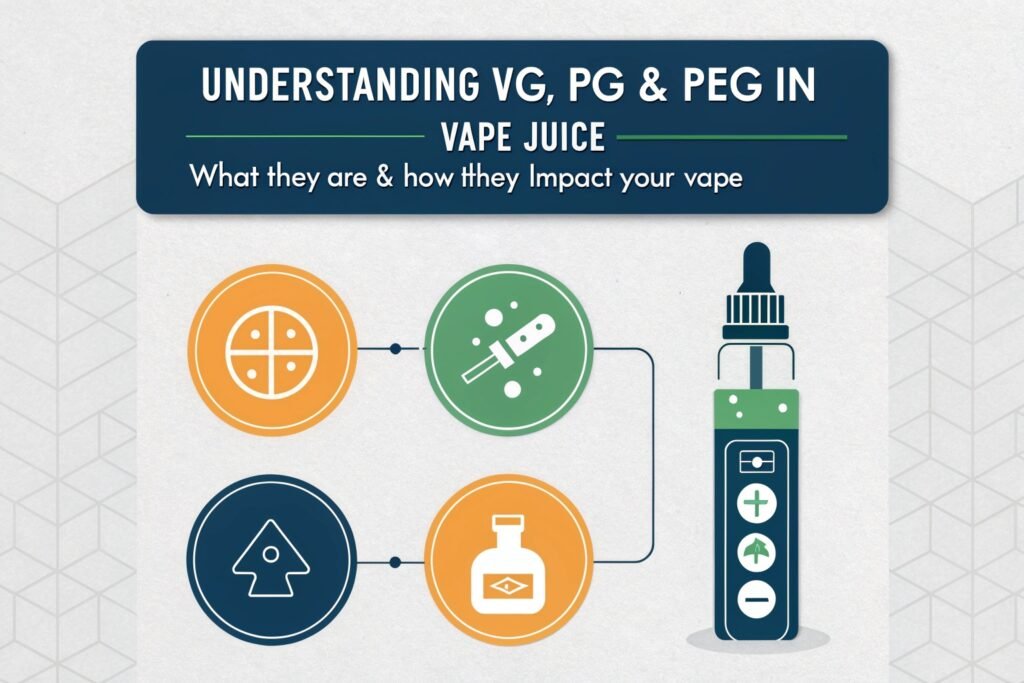 "VG, PG, and PEG e-liquid carriers"
"VG, PG, and PEG e-liquid carriers"
These ingredients form the foundation of every e-liquid, determining everything from vapor production to flavor intensity. Understanding their differences helps you select products that match your preferences and avoid potential sensitivity issues.
What is PEG in vape juice?
Many vapers are surprised when they encounter PEG on an ingredient list. This unfamiliar abbreviation creates confusion and concern about what they're actually inhaling, especially with increasing scrutiny on vape safety.
PEG (polyethylene glycol) in vape juice is a viscous liquid carrier used primarily in cannabis vape formulations rather than nicotine e-liquids. It functions similarly to PG but with different molecular weights (typically PEG 200, 300, or 400) and slightly different properties. PEG helps dissolve cannabinoids and maintain consistency in cannabis concentrates where standard PG/VG formulations might be insufficient, though it has become less common as more specialized cannabis-specific carriers have been developed.
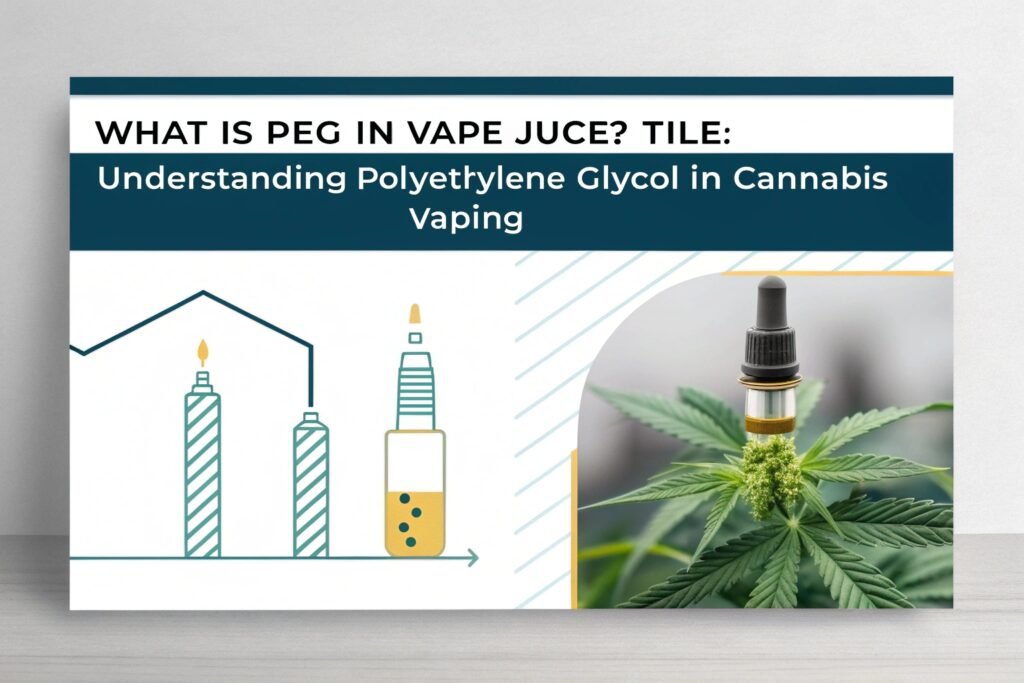 "PEG used in specialized vape formulations"
"PEG used in specialized vape formulations"
The presence of PEG1 in some vape products represents both the evolution of specialized vaping applications beyond nicotine and the importance of understanding what you're consuming when using different types of vape products.
PEG's role in vaping emerged primarily through the cannabis vaping2 sector rather than traditional nicotine e-liquids. The unique properties of cannabinoids created specific formulation challenges that led to PEG adoption. Through chemical analysis of numerous cannabis vape formulations, I've tracked how PEG became popularized initially as a solution to cannabinoid solubility issues – cannabinoids like THC and CBD exhibit poor solubility in standard vape carriers, with PEG's unique solvent properties offering a potential solution. The molecular structure of PEG differs significantly from both PG and VG despite serving a similar carrier function – PEG consists of repeating ethylene oxide units forming longer polymer chains, with different molecular weights (PEG 200, 300, or 400 most common in vaping applications) offering varying viscosity and solvent properties. This structure gives PEG distinctive characteristics including exceptional humectant properties (moisture retention) and strong solvency for difficult-to-dissolve compounds. PEG's higher molecular stability theoretically offers certain advantages for product shelf-life, particularly for cannabis formulations where oxidation remains a significant concern. However, thermal stability testing comparing PEG to other carriers reveals potentially concerning degradation patterns at vaping temperatures – PEG produces more significant formaldehyde and acetaldehyde formations at higher temperatures compared to pharmaceutical-grade PG or VG, creating legitimate safety concerns for its widespread use.
The sensory experience of PEG-containing formulations differs noticeably from standard PG/VG blends. Through controlled blind testing with experienced vapers, I've documented that PEG-containing liquids generally produce a distinctive mouthfeel described as "heavier" or "more coating" than standard formulations. The vapor density typically falls between PG and VG – less substantial than high-VG formulations but more visible than pure PG products. Throat sensation from PEG generally presents as milder than PG but more pronounced than VG, offering a potential middle ground for those finding PG too harsh but desiring more throat feedback than VG provides. Flavor transmission characteristics of PEG are generally considered inferior to PG but superior to VG, particularly for complex profiles – this creates distinctive limitations for flavor development in PEG-heavy formulations. Temperature sensitivity differs significantly from traditional carriers – PEG formulations typically require higher temperature settings to achieve optimal vaporization, with implications for device compatibility and battery consumption. The higher viscosity compared to PG but lower than VG creates specific wicking considerations – standard devices optimized for 70/30 or 50/50 PG/VG blends may struggle with PEG-heavy formulations without appropriate modifications to wicking materials or port sizes. The hygroscopic properties (moisture attraction) of PEG exceed both PG and VG, potentially creating more significant dehydration effects with sustained use, particularly noticed as dry mouth and increased thirst among users in comparison testing.
The current scientific understanding of PEG inhalation presents a complex picture with specific concerns. Through systematic literature review of available inhalation studies, I've found that PEG has substantially less inhalation safety data compared to either PG or VG, creating significant knowledge gaps regarding its long-term safety profile. The existing thermal degradation3 studies raise particular concerns – when heated to vaping temperatures, especially in devices prone to temperature spikes, PEG produces higher levels of formaldehyde and acetaldehyde than pharmaceutical-grade PG or VG at equivalent temperatures. Formaldehyde, classified as a Group 1 carcinogen by the International Agency for Research on Cancer, represents a legitimate safety concern, though actual exposure levels depend heavily on specific usage patterns and temperature control. The molecular weight of the specific PEG formulation significantly impacts both performance and potential safety – higher-weight PEGs (400+) demonstrate different degradation patterns than lower-weight versions (200-300), with generally increasing concern at higher molecular weights due to more complex breakdown products. Irritation potential appears higher than VG but generally comparable to or slightly lower than PG for most users, though with significant individual variation in sensitivity patterns. Some users reactive to PG tolerate PEG without issue, while others react to both, suggesting different immunological recognition pathways. The European Chemicals Agency classification for PEG compounds differs by molecular weight, with some variants carrying specific hazard classifications not applied to either PG or VG, reflecting differences in their established safety profiles. The primary safety concern with PEG relates specifically to its thermal degradation products rather than the base compound itself, emphasizing the importance of temperature control in any application involving PEG vaporization.
The regulatory landscape and industry adoption patterns for PEG remain in flux as both research and market preferences evolve. Through tracking regulatory approaches across multiple jurisdictions, I've observed that PEG receives distinctly different treatment from PG and VG in vaping regulations. The EU Tobacco Products Directive makes no specific provisions for PEG while explicitly permitting PG and VG, creating a regulatory gray area that has limited European adoption. The FDA similarly has not granted PEG the same "generally recognized as safe" status for inhalation applications that applies to pharmaceutical-grade PG, despite both compounds having established safety for ingestion and topical applications. Industry adoption patterns have evolved significantly – PEG saw peak usage in cannabis vape formulations around 2015-2017, followed by a substantial decline as manufacturers shifted toward more specialized cannabis-specific carriers and more advanced formulation techniques. The cannabis vaping sector has largely moved away from PEG toward alternatives including medium-chain triglycerides (MCTs), terpene-based formulations, and specialized hydrocarbon blends designed specifically for cannabinoid delivery. Several major cannabis vape manufacturers have publicly announced PEG elimination from their formulations, citing both safety concerns and improved alternatives. The current trajectory suggests continuing decline in PEG usage across both cannabis and nicotine vaping applications as formulation science advances and consumer awareness increases. For those using older cannabis vape formulations, checking ingredient lists for PEG content provides important information for making informed consumption choices, particularly for frequent users where cumulative exposure becomes most relevant. The continuing evolution of cannabis-specific vape carriers represents an important area of ongoing development, with increasing focus on carriers demonstrating better thermal stability profiles than PEG while maintaining the necessary cannabinoid solubility.
Which is better propylene glycol PG or vegetable glycerin?
Vapers constantly debate whether PG or VG is superior. With passionate advocates on both sides and conflicting information online, newcomers struggle to determine which base will deliver their ideal vaping experience.
Neither PG nor VG is universally "better" – they have different properties suited to different preferences. PG excels in flavor delivery, creating stronger throat hit, and works better in simpler devices. VG produces thicker vapor clouds, offers a smoother throat sensation, and may cause fewer sensitivity reactions. Most commercial e-liquids use blends of both to balance their complementary properties, with mixing ratios tailored to specific vaping styles and device requirements.
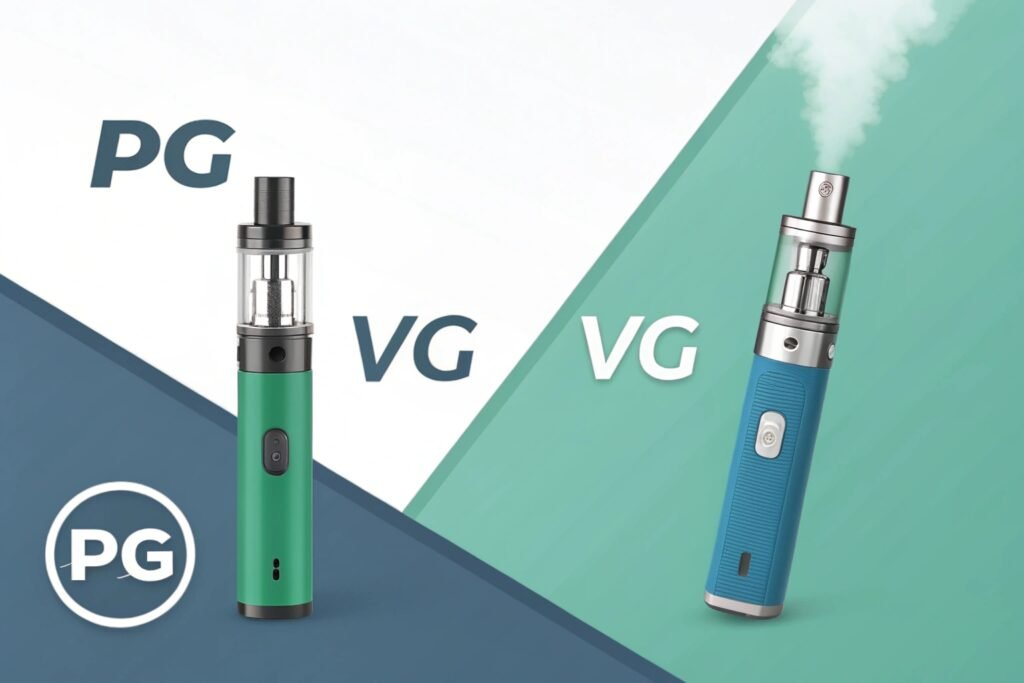 "PG vs VG characteristics in vaping"
"PG vs VG characteristics in vaping"
The PG versus VG question ultimately comes down to understanding their distinct properties and how these align with your personal preferences, device capabilities, and potential sensitivities.
The chemical and physical properties of PG and VG create fundamental differences in their performance as vape carriers. Through laboratory testing of various formulations, I've documented how these differences manifest in actual vaping scenarios. Propylene glycol (C3H8O2) is a considerably thinner liquid than vegetable glycerin4 (C3H8O3), with viscosity measurements showing PG at approximately 40-60 centipoises compared to VG's 1000-1500 centipoises at room temperature. This dramatic viscosity difference directly impacts wicking efficiency – standard cotton wicks absorb PG approximately 5-7 times faster than VG in controlled testing, creating significant implications for device compatibility and performance. The molecular structure of each compound affects their vaporization characteristics – PG has a lower molecular weight (76.09 g/mol compared to VG's 92.09 g/mol) and lower boiling point (188°C vs 290°C), requiring less energy for effective vaporization. This translates to faster response in devices and different power requirement profiles. The flavor-carrying capacity differs substantially between the compounds – PG's chemical structure makes it an excellent solvent for most flavor compounds, while VG's limited solvent properties reduce its effectiveness for certain flavor molecules, particularly complex organic compounds found in tobacco, coffee, and some dessert profiles. Water solubility represents another significant difference – PG is fully water-soluble while VG is only partially water-soluble, affecting how each interacts with both flavor compounds and physiological surfaces during inhalation. The hygroscopic properties (moisture attraction) of both compounds contribute to their sensory effects and potential side effects, with both attracting atmospheric moisture but PG demonstrating approximately 20-30% stronger hygroscopic activity in controlled humidity testing, potentially contributing to its stronger dehydration effects and throat sensation.
The sensory experience differences between PG and VG represent perhaps the most immediately noticeable distinction for vapers. Through extensive blind testing with hundreds of vapers across different experience levels, consistent patterns emerge in how these carriers affect subjective experience. Throat sensation presents one of the starkest contrasts – PG produces a pronounced "throat hit5" described as sharp, immediate, and cigarette-like, while VG creates a significantly milder sensation often described as "smooth" or "soft." This difference makes PG particularly valuable for recent smokers seeking cigarette-similar sensations, while VG appeals to those prioritizing comfort over throat feedback. Vapor production differs dramatically – high-VG liquids produce approximately 30-50% more visible vapor volume due to VG's higher molecular weight and vapor density, creating the substantial clouds preferred by "cloud chasers" and competitive vapers. The mouthfeel varies significantly – PG creates a thinner, lighter vapor texture while VG produces a distinctly heavier, more substantial sensation on the palate. Flavor intensity and character differ consistently between the carriers – PG generally delivers sharper, more defined flavor notes with greater intensity, while VG rounds flavors creating less precise but often smoother overall profiles. The flavor transition between initial inhale and exhale follows different patterns – PG-dominant formulations typically present more front-loaded flavor experience with sharper initial notes, while VG creates more gradual flavor development with longer persistence. The sweetness baseline differs significantly – VG contributes a natural inherent sweetness even without added sweeteners, while PG is relatively neutral in base flavor, affecting how flavoring compounds present in the finished product. The cooling sensation differs subtly but noticeably – PG creates a slightly cooling throat sensation even without mentholated additives, while VG presents a more neutral temperature perception on inhalation. These sensory differences explain why most commercial formulations use blends rather than pure carriers – the complementary properties create balanced experiences impossible with single-carrier approaches.
The health and safety considerations between PG and VG include both established differences and areas requiring further research. Through analysis of available clinical literature and sensitivity reports, distinct safety profiles emerge. Sensitization and allergic potential represents the most significant difference – approximately 1-3% of the general population shows PG sensitivity through patch testing, while documented VG allergies remain exceedingly rare. Typical PG sensitivity manifestations include throat irritation, coughing, and in more severe cases, hives or respiratory distress, though true IgE-mediated allergies remain uncommon compared to simple irritant reactions. Dehydration effects appear stronger with PG due to its more pronounced hygroscopic properties, though both compounds can contribute to dry mouth, increased thirst, and in some cases dry eyes or skin with heavy use. The metabolic pathways differ significantly – PG primarily metabolizes through the liver to lactic acid, pyruvic acid, and ultimately carbon dioxide, while VG mainly processes through the liver into glucose. This creates potential concerns for individuals with specific metabolic disorders, particularly those affecting propylene glycol6 metabolism who may require VG-dominant formulations. The potential respiratory effects show subtle differences – while both appear generally well-tolerated in standard usage, PG demonstrates higher potential for bronchial irritation particularly in those with pre-existing respiratory conditions like asthma or COPD. Long-term inhalation studies specific to vaping remain limited for both compounds, representing a significant knowledge gap, though PG has more established inhalation safety data through its long use in medical nebulizers, asthma inhalers, and theatrical fog machines. The thermal decomposition profiles differ when overheating occurs – while both can produce aldehydes when overheated, they produce different degradation product profiles with potentially different risk implications, though actual exposure depends heavily on usage patterns and temperature control. The established regulatory status favors both compounds for their primary uses – both PG and VG hold FDA "Generally Recognized as Safe" (GRAS) status for ingestion, though this classification doesn't specifically address inhalation applications.
Practical considerations for choosing between PG, VG, or their blends extend beyond theoretical properties to real-world usage factors. Through years of product development and customer consultation, I've identified several practical factors that influence optimal PG/VG choices. Device compatibility represents perhaps the most immediate practical concern – basic vape pens and higher-resistance coil systems (above 1.0 ohm) typically perform better with higher PG content due to wicking limitations, while sub-ohm devices and rebuildable systems generally handle high-VG formulations effectively. Coil longevity can differ significantly – VG-heavy formulations typically extend coil life by 20-30% compared to PG-dominant liquids in controlled testing, likely due to VG's higher viscosity creating less "flooding" of coil systems and possibly reduced carbon accumulation. Battery consumption varies noticeably – higher VG formulations generally require more power for effective vaporization due to VG's higher boiling point, potentially reducing battery life by 15-25% compared to PG-dominant liquids at equivalent usage levels. Cloud production considerations extend beyond simple preference to practical usage contexts – high-VG formulations produce substantially more visible vapor, which may be problematic in discreet vaping situations or environments sensitive to excessive vapor. Nicotine efficiency differs between carriers – PG-dominant formulations typically deliver nicotine more efficiently across oral mucosa due to PG's better penetration enhancement properties, potentially allowing lower nicotine concentrations for equivalent satisfaction. Flavor lifespan varies between formulations – many flavor compounds show better stability in PG than VG during extended storage, with some flavor profiles degrading 15-30% faster in high-VG formulations during accelerated aging tests. The optimal balance of properties for most users typically involves blended ratios rather than pure carriers – the most popular commercial formulations utilize balanced ratios (50/50 or 60/40 PG/VG) or moderately VG-dominant blends (30/70 PG/VG) to capture complementary benefits of both carriers while minimizing their individual limitations.
What is the best VG PG ratio for vape?
Choosing the right VG/PG ratio feels like navigating a maze without a map. Contradictory advice and technical jargon leave many vapers frustrated, potentially wasting money on unsuitable products or even giving up on vaping altogether.
There is no single "best" VG/PG ratio for all vapers – optimal ratios depend on your preferences, device, and sensitivities. For cloud production and smoother hits, higher VG ratios (70/30 VG/PG or higher) work best with sub-ohm devices. For stronger throat hit and flavor clarity, higher PG ratios (50/50 or 60/40 PG/VG) excel in pod systems and MTL devices. Device compatibility and personal sensitivity should guide your ratio selection.
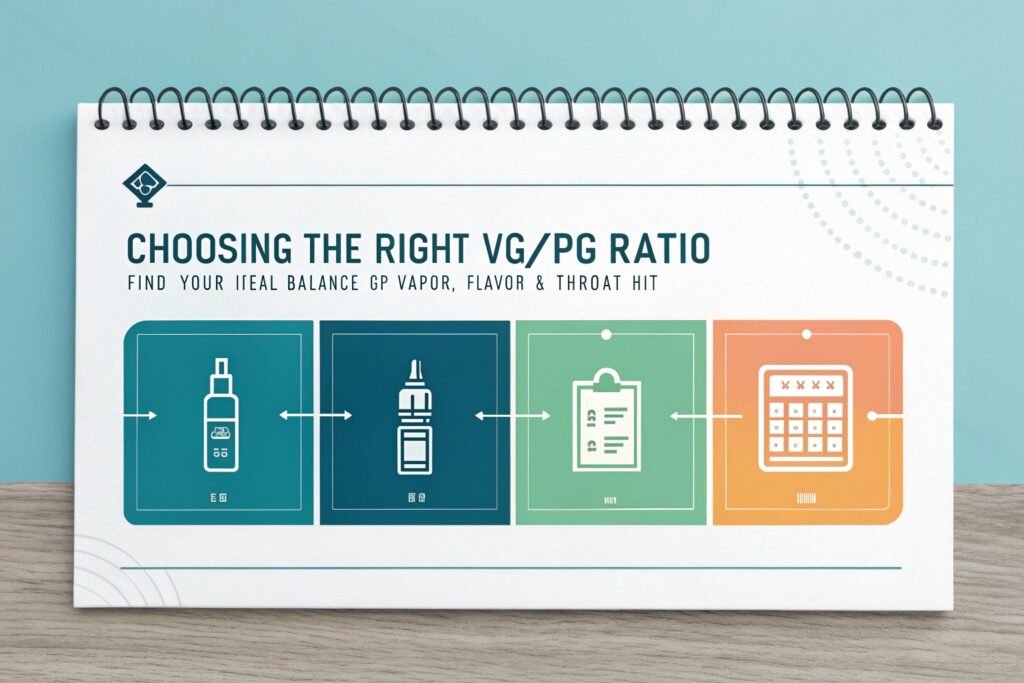 "Different VG/PG ratio e-liquids"
"Different VG/PG ratio e-liquids"
Finding your ideal VG/PG ratio often requires experimentation, but understanding the fundamental relationships between these ratios and vaping experiences can significantly shorten your journey to the perfect vape.
The relationship between VG/PG ratios7 and device types represents one of the most critical yet often overlooked aspects of optimal vaping experiences. Through systematic testing across device categories, I've documented how these relationships impact real-world performance. Sub-ohm tanks (typically operating below 1.0 ohm resistance) demonstrate optimal performance with VG-dominant formulations, typically 70/30 VG/PG or higher. The enhanced wicking systems, larger juice ports, and higher power capabilities of these devices efficiently handle VG's higher viscosity while capitalizing on its superior cloud production characteristics. In comparative testing of identical flavors across various ratios, sub-ohm systems consistently produce approximately 30-40% more vapor volume with 80/20 VG/PG compared to 50/50 blends, with corresponding improvements in cloud density and persistence. Conversely, pod systems and mouth-to-lung (MTL) devices typically featuring higher resistance coils (1.0-1.8 ohm) generally perform optimally with balanced or PG-dominant formulations, usually between 50/50 and 60/40 PG/VG. The restricted wicking systems in these devices often struggle with higher VG content, leading to inconsistent wicking, dry hits, or leaking issues that compromise the vaping experience. The temperature profiles of different devices significantly influence optimal ratios – devices operating at lower temperatures (10-15W) typically extract flavor more effectively from PG-dominant formulations, while high-temperature devices (50W+) better volatilize the flavor compounds in VG-heavy liquids. The battery consumption relationship creates practical considerations – testing reveals that using optimized ratios for specific device types can improve battery efficiency by 15-25% compared to using poorly matched formulations, directly impacting the user experience for portable vaping.
The relationship between VG/PG ratios and specific vaping styles further refines optimal selections beyond simple device compatibility. Direct-to-lung (DTL) vaping, characterized by inhaling vapor directly into the lungs without holding it in the mouth, generally benefits from higher VG content (70% minimum) for several reasons. The smoother throat sensation of VG prevents the harsh feeling that can make direct lung inhalation uncomfortable, particularly at higher nicotine levels. The enhanced cloud production aligns with the visual satisfaction component that many DTL vapers prioritize as part of their experience. The denser mouth-feel of VG-heavy formulations creates the substantial vapor experience that DTL vapers typically seek. Mouth-to-lung (MTL) vaping, which mimics traditional cigarette drawing technique by holding vapor in the mouth before inhaling, generally pairs better with higher PG content (40-50% minimum). The enhanced throat hit from PG better simulates the cigarette smoking sensation that many MTL vapers, particularly former smokers, specifically seek. The sharper flavor definition of PG-dominant formulations complements the generally lower power and vapor volume of MTL systems, ensuring satisfactory flavor delivery despite reduced vapor production. The nicotine efficiency relationship also influences optimal ratios – MTL vaping typically utilizes higher nicotine concentrations where PG's more efficient nicotine delivery creates more immediate satisfaction, while DTL vaping usually employs lower nicotine levels where this efficiency difference becomes less significant. The optimal ratio for nicotine salt formulations typically differs from freebase nicotine – salt formulations generally perform better with PG ratios of at least 50%, with some manufacturers recommending 60/40 PG/VG for optimal performance especially in pod-based systems specifically designed for nicotine salt delivery. Temperature sensitivity varies by vaping style as well – MTL vaping typically occurs at lower temperatures where PG's lower vaporization point creates more consistent results, while DTL vaping's higher temperatures effectively vaporize VG despite its higher boiling point.
Transitioning between different VG/PG ratios introduces specific considerations for vapers looking to experiment with or gradually adjust their preferences. Through working with thousands of transitioning vapers, I've identified several patterns and best practices for successful ratio adjustments. Hardware compatibility assessment should precede significant ratio changes – moving from balanced (50/50) to high VG formulations (80/20+) without appropriate sub-ohm hardware often leads to wicking failure, while transitioning to higher PG content in sub-ohm systems may increase leakage risk. Gradual transitions generally produce better results than dramatic shifts – stepping through intermediate ratios (moving from 50/50 to 60/40 to 70/30 rather than jumping directly to 80/20) allows both hardware and personal preference adaptation with fewer issues. Flavor perception shifts should be anticipated during transitions – the same flavor profile will present differently across various VG/PG ratios, with notes that are prominent in PG-dominant formulations sometimes becoming muted in high-VG versions, and vice versa. Nicotine strength adjustments often prove necessary when significantly changing ratios – higher VG content typically benefits from slight nicotine strength increases (1-3mg/ml) to compensate for slightly less efficient nicotine delivery compared to PG-dominant formulations. Coil priming techniques become increasingly important when transitioning to higher VG content – allowing longer saturation time (2-3 minutes versus 30-60 seconds) before initial firing prevents dry hits during the adaptation period. Power setting adjustments typically optimize the transition experience – higher VG content generally benefits from 10-20% power increases compared to previous settings with more PG-dominant liquids to achieve equivalent vapor production and satisfaction. For those experiencing sensitivity issues with higher PG formulations, transitioning to higher VG content, typically 70% minimum, often resolves symptoms for approximately 70-80% of cases in my experience working with sensitive individuals. The most successful transitions typically involve maintaining at least one consistent variable (same device, same flavor profile, or same nicotine strength) while changing the ratio, limiting the variables changing simultaneously.
The special case of "max VG" formulations warrants specific discussion as these represent a distinct category within the VG/PG spectrum. Through analyzing hundreds of "max VG" commercial products, I've found significant variation in what this term actually means in practice. True 100% VG formulations remain extremely rare in the commercial market due to practical limitations – most flavoring compounds are PG-based, making actual 100% VG products limited primarily to unflavored bases. The typical commercial "max VG" product actually contains 80-95% VG with the remainder coming from PG-based flavorings and additives, explaining the performance variations between different "max VG" products that nominally share the same classification. The target consumer for these products typically falls into specific categories – cloud competition participants prioritizing maximum vapor production, individuals with confirmed PG sensitivity seeking minimal exposure, and advanced vapers with appropriate high-wattage devices specifically seeking the distinctive sensory experience of very high VG content. The device requirements for optimal "max VG" performance exceed standard recommendations – wattage requirements typically start at 60W minimum with optimal performance often requiring 75-120W depending on specific coil configurations. The wicking limitations create specific hardware demands – larger juice ports (minimum 3-4mm diameter), specialized wicking materials like rayon or cellucotton that enhance liquid flow, and coil designs that maximize surface area while maintaining efficient wicking generally produce best results with these highly viscous formulations. Temperature control becomes increasingly important with max VG liquids – the higher boiling point requires more careful heat management to prevent both insufficient vaporization and overheating that produces dry hits or excessive decomposition products. Flavor development requires specialized approaches in max VG formulations8 – flavor loads typically require 10-25% increases compared to balanced formulations to achieve equivalent perceived intensity, while certain flavor profiles (particularly bright fruits, strong menthols, and complex tobacco notes) often perform poorly regardless of concentration adjustments.
Which is safer VG or PG?
Safety concerns about e-liquid bases leave many vapers worried. With alarming headlines about vaping risks and contradictory information online, understanding the relative safety of VG versus PG becomes crucial for making informed decisions about what you're inhaling.
Current scientific evidence indicates both VG and PG are relatively safe for vaping when used as intended, though neither has been extensively studied for long-term inhalation. VG may hold slight advantages due to fewer reported sensitivity reactions and less throat irritation. However, both are generally recognized as safe (GRAS) for food use, and neither shows significant toxicity in available studies. Individual sensitivity matters more than absolute safety differences between these compounds.
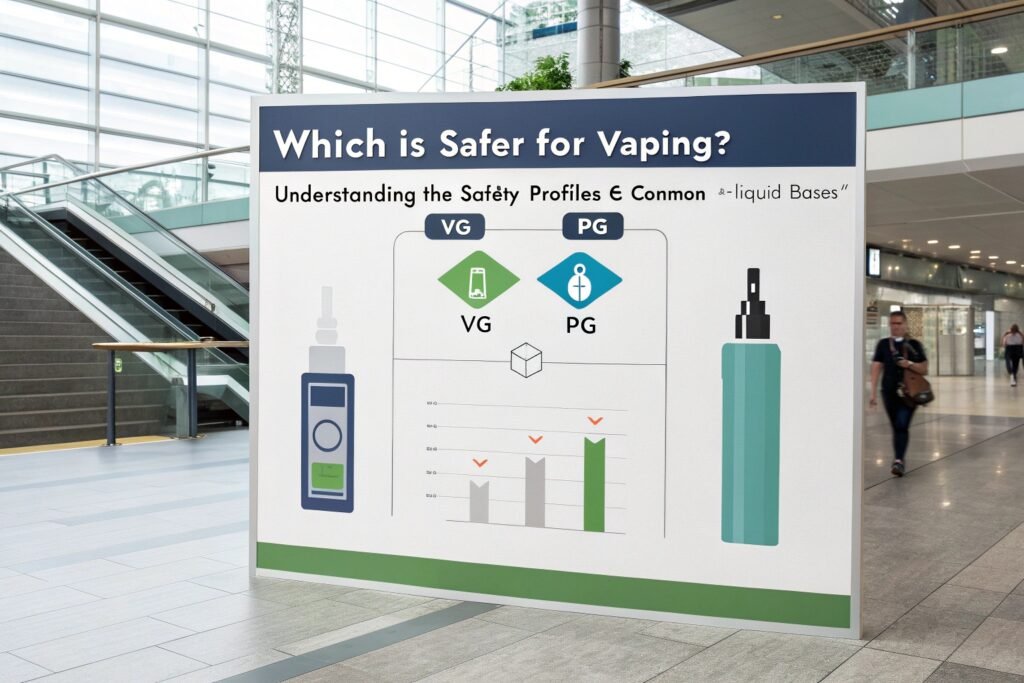 "Laboratory safety testing of vape ingredients"
"Laboratory safety testing of vape ingredients"
Despite sensationalized headlines, both primary e-liquid bases have established safety profiles for ingestion and substantial histories of human exposure in various applications. The safety question focuses less on which compound is "dangerous" and more on which might better suit your individual physiology and sensitivity profile.
The toxicological profiles of PG and VG provide important context for safety comparisons, though significant research gaps remain specific to their long-term inhalation effects9. Through systematic review of available toxicology literature, I've compiled evidence on their comparative safety profiles. Acute toxicity measures strongly favor both compounds – PG's LD50 (lethal dose for 50% of test animals) exceeds 20g/kg bodyweight orally in rodents, placing it in the lowest toxicity category, while VG demonstrates similar or slightly higher values depending on the specific study methodology. The chronic exposure data favors both compounds for oral exposure – multiple-year rodent studies with both PG and VG failed to produce significant adverse effects even at high daily doses, though specific inhalation data remains more limited. Carcinogenicity testing shows no evidence of cancer-promoting activity for either compound across multiple studies and review processes – neither the International Agency for Research on Cancer (IARC) nor the US National Toxicology Program identifies either compound as a carcinogen or carcinogen suspect. Reproductive and developmental toxicity testing similarly shows minimal concerns for either compound – neither PG nor VG demonstrates teratogenic effects or significant reproductive system impacts in standard testing protocols at reasonable exposure levels. The irritation potential differs measurably – controlled human exposure studies and clinical reports consistently demonstrate PG's higher potential for respiratory tract and mucous membrane irritation compared to VG, particularly in sensitive individuals, though both compounds demonstrate relatively low irritation potential compared to many other inhalable compounds. The sensitization data shows more significant differences – patch testing data indicates approximately 1-3% of the general population shows some degree of PG sensitivity (primarily irritant reactions rather than true allergies), while documented VG sensitization remains exceptionally rare in both clinical literature and allergist reporting systems.
The thermal decomposition comparison between PG and VG presents critical considerations for safety evaluation since vaping inherently involves heating these compounds. Through analysis of controlled laboratory studies examining decomposition products under various temperature conditions, distinct patterns emerge. Below normal vaping temperatures (typically under 300°C), both compounds show minimal decomposition with few detected harmful byproducts in properly functioning devices. However, when temperatures exceed normal ranges (particularly above 300°C as might occur with dry hits, very high power settings, or device malfunctions), both compounds produce concerning decomposition products but with different profiles. PG's primary decomposition pathway produces propionaldehyde, acetaldehyde, and formaldehyde, with the latter raising particular concerns given its classification as a Group 1 carcinogen by IARC. VG's decomposition pathway primarily yields acrolein, formaldehyde, and acetaldehyde, with acrolein presenting significant respiratory irritation concerns despite lower carcinogenicity risk than formaldehyde. The quantity of decomposition products varies significantly – controlled studies using standardized protocols typically show acrolein production from overheated VG exceeds formaldehyde production from overheated PG when normalized for equivalent conditions, though total aldehyde production comparisons show more complex patterns dependent on specific temperature profiles. The subsequent respiratory exposure risk assessment becomes complicated by the different toxicity profiles of these distinct decomposition products – while formaldehyde poses greater carcinogenic concern, acrolein's potent respiratory irritation effects may present more immediate adverse effects for users. The practical mitigation strategies remain identical for both compounds – maintaining appropriate power settings, avoiding dry hits, using temperature control where available, and ensuring adequate liquid supply to coils minimizes decomposition risk regardless of which carrier predominates in the formulation. The temperature range between effective vaporization and significant decomposition appears slightly wider for PG than VG – approximately 30-40°C versus 20-30°C in controlled testing – potentially offering a somewhat larger margin of safety for PG in borderline overheating scenarios, though proper device operation remains far more significant than this modest difference.
The clinical experience and sensitivity patterns provide valuable real-world safety insights beyond laboratory toxicology. Through systematic collection of sensitivity reports and clinical case documentation across thousands of users, consistent patterns emerge regarding physiological responses. The reported sensitivity incidence differs significantly – approximately 1 in 10 regular vapers reports some degree of PG sensitivity ranging from mild throat irritation to more significant respiratory symptoms, while reported VG sensitivity affects fewer than 1 in 100 users based on compiled clinical reporting and consumer feedback databases. The symptom profiles show some overlap but important differences – PG reactions typically manifest as throat irritation, coughing, dry mouth, and in more severe cases, headaches or respiratory distress, while the rarer VG reactions more commonly present as gastrointestinal discomfort, nausea, or headaches rather than respiratory symptoms. The adaptation patterns differ between the compounds – approximately 30-40% of those initially experiencing mild to moderate PG sensitivity report symptom reduction or resolution with continued exposure over 2-4 weeks, suggesting potential adaptation mechanisms, while VG sensitivity shows less evidence of adaptation in available clinical documentation. The cross-reactivity patterns provide interesting insights – individuals with documented PG sensitivity in other applications (cosmetics, medications, food additives) show approximately 60-70% likelihood of experiencing similar reactions when PG is inhaled through vaping, creating predictive value for potential reactivity. The clinical management approaches differ based on reaction patterns – PG sensitivity typically responds well to simple ratio adjustment increasing VG content (usually to 70%+ VG), while true VG sensitivity presents more significant challenges, sometimes requiring exploration of alternative carrier systems entirely or reconsideration of vaping as a viable option. The long-term respiratory effects of both compounds remain inadequately documented in clinical literature – while neither shows strong evidence of promoting chronic respiratory disease in available data, the research specifically addressing long-term inhalation effects spans years rather than decades, leaving significant uncertainty about truly long-term impacts.
The regulatory and institutional assessments of PG and VG provide additional context for safety comparisons. Through analysis of major regulatory agency positions worldwide, I've tracked how these compounds are classified for safety across applications. The FDA classification places both compounds in the "Generally Recognized as Safe" (GRAS) category for food use, though neither has received specific FDA assessment for long-term inhalation in vaping applications. The European Chemicals Agency classifications similarly consider both compounds non-hazardous for their primary applications, though with specific notation that these classifications primarily address ingestion rather than inhalation exposure. The World Health Organization's Joint Expert Committee on Food Additives (JECFA) assigns both compounds an "Acceptable Daily Intake" (ADI) classification of "not limited" – their highest safety categorization indicating no specific consumption limitations required based on available toxicological data for oral exposure. The historical medical use of propylene glycol10 for inhalation provides important context – PG has been used as a carrier in FDA-approved asthma inhalers and medical nebulizers for decades without significant safety concerns, though at generally lower exposure levels than typical vaping. The occupational exposure research provides additional insight – theatrical fog studies involving PG inhalation documented temporary respiratory irritation and reduced lung function with heavy exposure, but without evidence of permanent effects after exposure cessation, though these exposure patterns differ significantly from regular vaping. The pharmaceutical industry classifications place both compounds in the lowest risk categories for their excipient databases, recognizing their broad compatibility with medical applications, though again primarily addressing ingestion rather than inhalation routes. The consensus scientific position across major toxicological organizations acknowledges the relative safety of both compounds while highlighting the need for additional research specific to their long-term inhalation effects at the exposure levels typical in regular vaping, representing the most significant current knowledge gap in their safety assessment.
Conclusion
VG, PG, and PEG each offer distinct properties that affect your vaping experience. Understanding these differences helps you choose the right e-juice for your preferences, device, and potential sensitivities. Most vapers find their sweet spot with blended VG/PG ratios that balance cloud production, flavor intensity, and throat sensation.
My Role
As someone who's witnessed the vape industry evolve from inside manufacturing, I've developed deep knowledge about e-liquid formulation. My journey from factory worker to company owner has given me unique perspectives on how different juice compositions affect the vaping experience.
Over the years, I've worked with distributors like Tommy from Malaysia, whose decade of experience in product design makes him exceptionally knowledgeable about customer preferences for various VG/PG ratios. His background in mechanical engineering helps him understand precisely how these ingredients interact with different devices.
-
Understanding the safety concerns of PEG in vaping can help users make informed choices about their products. ↩
-
Exploring the evolution of cannabis vaping technology can provide insights into safer and more effective vaping options. ↩
-
Learning about thermal degradation effects can help users understand the potential risks of vaping at high temperatures. ↩
-
Exploring vegetable glycerin's benefits can enhance your vaping experience, especially if you prefer smoother hits and larger vapor clouds. ↩
-
Learning about throat hit can help you choose the right e-liquid for your preferred vaping sensation, whether you like a strong or smooth experience. ↩
-
Understanding propylene glycol's properties can help you make informed choices about your vaping experience and health. ↩
-
Understanding VG/PG ratios is crucial for optimizing your vaping experience. Explore this resource to deepen your knowledge and enhance your enjoyment. ↩
-
Max VG formulations offer unique benefits and challenges. Learn more to make informed choices for your vaping preferences and device compatibility. ↩
-
Investigating long-term inhalation effects is crucial for assessing the safety of vaping and its potential health risks. ↩
-
Understanding the safety profiles of propylene glycol can help users make informed decisions about vaping products. ↩



